A Numerical Investigation of Transformation Rates from Debris Flows to Turbidity Currents under Shearing Mechanisms
Abstract
:1. Introduction
2. Transformation Mechanisms
2.1. Liquefaction
2.2. Breaking Up of Flow
2.3. Shearing on Top Leading to Erosion
2.4. Mixing due to Instability and Wave Formation
2.5. Mixing under and into the Head of the Flow
2.6. Hydraulic Jump
3. Methodology
3.1. Numerical Models
3.2. Two-Phase Flow Module
3.3. Validation
4. Numerical Analyses
4.1. Model Setup
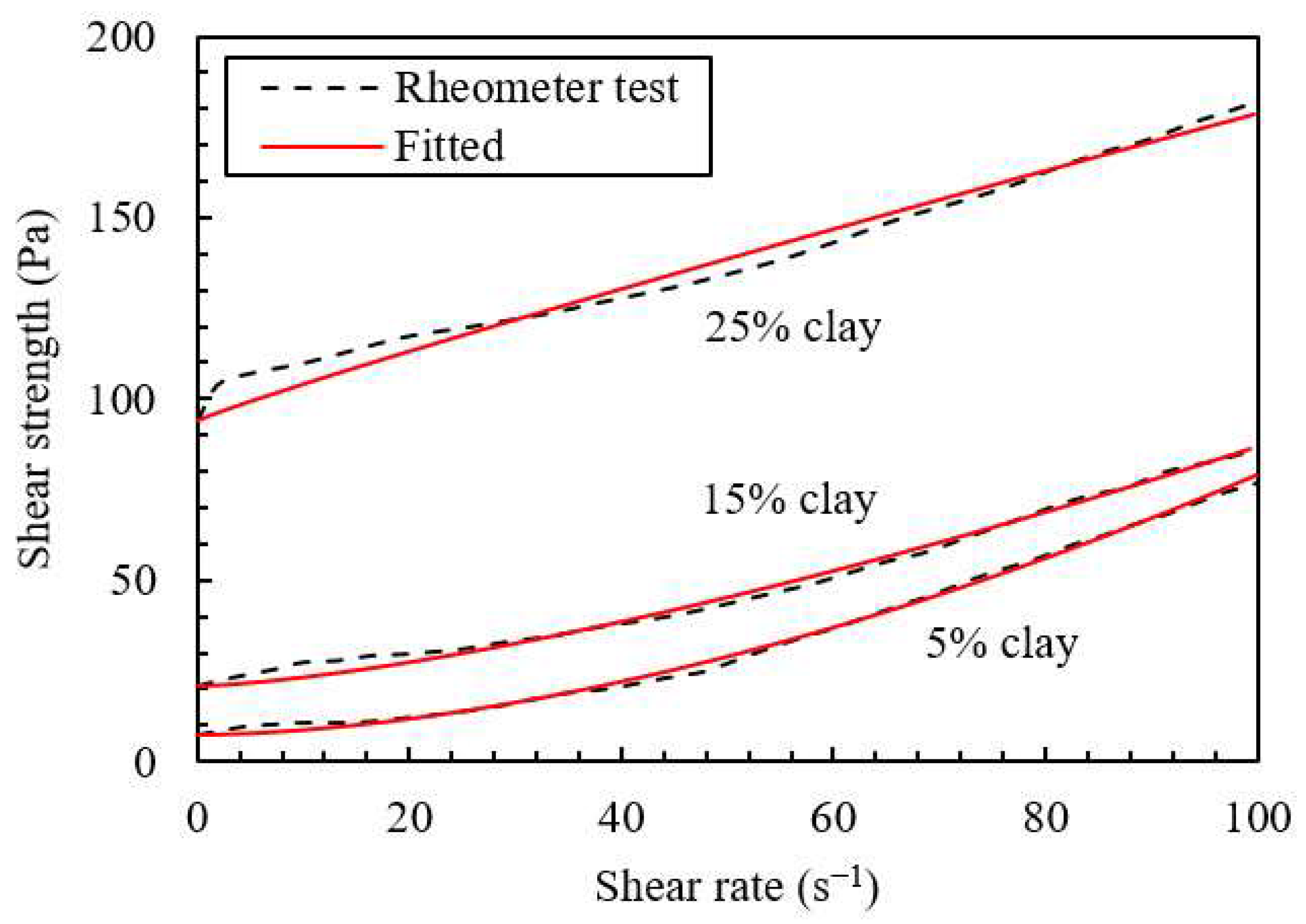
4.2. Modelling of the Transformation Process
4.3. Shearing Mechanism
5. Parametric Studies
5.1. Shear Strength of the Debris Flow
5.2. Slope Angle and Flow Depth
| Case | Slope Angle θ (°) | Initial Thickness H (m) | Yield Strength su0 (Pa) | Transformation Rate E (m/s) | Representative Velocity v (m/s) |
|---|---|---|---|---|---|
| 1 | 6 | 0.3 | 7 | 8.29 | 1.02 |
| 2 | 6 | 0.3 | 20 | 8.08 | 0.79 |
| 3 | 6 | 0.3 | 95 | 4.38 | 0.42 |
| 4 | 6 | 0.3 | 290 | 1.33 | 0.13 |
| 5 | 6 | 0.3 | 750 | 0.25 | 0.02 |
| 6 | 6 | 0.5 | 7 | 12.38 | 1.53 |
| 7 | 6 | 0.5 | 20 | 11.53 | 1.04 |
| 8 | 6 | 0.5 | 95 | 7.93 | 0.56 |
| 9 | 6 | 0.5 | 290 | 4 | 0.34 |
| 10 | 6 | 0.5 | 750 | 0.78 | 0.09 |
| 11 | 6 | 0.8 | 7 | 13.84 | 1.86 |
| 12 | 6 | 0.8 | 20 | 12.42 | 1.76 |
| 13 | 6 | 0.8 | 95 | 8.69 | 1.27 |
| 14 | 6 | 0.8 | 290 | 5.03 | 0.77 |
| 15 | 6 | 0.8 | 750 | 1.95 | 0.28 |
| 16 | 1 | 0.5 | 7 | 10.68 | 0.72 |
| 17 | 1 | 0.5 | 20 | 10.03 | 0.68 |
| 18 | 1 | 0.5 | 95 | 6.58 | 0.43 |
| 19 | 1 | 0.5 | 290 | 3.53 | 0.17 |
| 20 | 1 | 0.5 | 750 | 0.65 | 0.05 |
5.3. Real-Scale Modelling
6. Conclusions
Author Contributions
Funding
Data Availability Statement
Conflicts of Interest
Nomenclature
| A | Volume fractions for unity |
| A0.3 | Volume fractions smaller than 0.3 |
| CD | Drag coefficient |
| dmin | Minimum mesh size |
| E | Erosion rate |
| Fm | A term that accounts for how the surface tension force affects the mixture |
| M | Coefficient |
| n | Shear-thinning index |
| ∇Pm | Pressure of the mixture |
| Su,H | Shear stress |
| Su0,H | Critical shear stress |
| su,B | Mobilized shear stress |
| su0,B | Yield stress under static loading |
| t | Elapse time |
| Δt | Time step |
| V | Volume of the flow |
| v | Velocity of the slurry |
| Δv | Velocity variance between debris flow and ambient water |
| α | Coefficient |
| β | Coefficient |
| γ | Shear strain rate |
| η | Plastic viscosity |
| µ | Coefficient of viscosity |
| ρ | Density of flow |
| τ | Shear stress |
| τ0 | Minimum value of shear stress |
References
- Sun, Q.; Wang, Q.; Shi, F.; Alves, T.; Gao, S.; Xie, X.; Wu, S.; Li, J. Runup of landslide-generated tsunamis controlled by paleogeography and sea-level change. Commun. Earth Environ. 2022, 3, 244. [Google Scholar] [CrossRef]
- Talling, P.J.; Paull, C.K.; Piper, D.J. How are subaqueous sediment density flows triggered, what is their internal structure and how does it evolve? Direct observations from monitoring of active flows. Earth-Sci. Rev. 2013, 125, 244–287. [Google Scholar] [CrossRef] [Green Version]
- Dong, Y.; Wang, D.; Randolph, M.F. Investigation of impact forces on pipeline by submarine landslide using material point method. Ocean Eng. 2017, 146, 21–28. [Google Scholar] [CrossRef]
- Dong, Y.; Wang, D.; Cui, L. Assessment of depth-averaged method in analysing runout of submarine landslide. Landslides 2020, 17, 543–555. [Google Scholar] [CrossRef]
- Meiburg, E.; Kneller, B. Turbidity currents and their deposits. Annu. Rev. Fluid Mech. 2010, 42, 135–156. [Google Scholar] [CrossRef] [Green Version]
- Locat, J.; Lee, H.J. Submarine landslides: Advances and challenges. Can. Geotech. J. 2002, 39, 193–212. [Google Scholar] [CrossRef]
- Zhang, W. Initiation and Mechanisms of Catastrophic Submarine Landslides. Ph.D. Thesis, The University of Western Australia, Perth, Australia, 2017. [Google Scholar]
- Guo, X.-S.; Nian, T.-K.; Gu, Z.-D.; Li, D.-Y.; Fan, N.; Zheng, D.-F. Evaluation methodology of laminar-turbulent flow state for fluidized material with special reference to submarine landslide. J. Waterw. Port Coast. Ocean Eng. 2021, 147, 04020048. [Google Scholar] [CrossRef]
- Elverhøi, A.; Harbitz, C.B.; Dimakis, P.; Mohrig, D.; Marr, J.; Parker, G. On the dynamics of subaqueous debris flows. Oceanography 2000, 13, 109–117. [Google Scholar] [CrossRef]
- Boukpeti, N.; White, D.; Randolph, M.; Low, H. Strength of fine-grained soils at the solid–fluid transition. Géotechnique 2012, 62, 213–226. [Google Scholar] [CrossRef] [Green Version]
- Mohrig, D.; Ellis, C.; Parker, G.; Whipple, K.X.; Hondzo, M. Hydroplaning of subaqueous debris flows. Geol. Soc. Am. Bull. 1998, 110, 387–394. [Google Scholar] [CrossRef]
- Huang, H.; Imran, J.; Pirmez, C. Numerical study of turbidity currents with sudden-release and sustained-inflow mechanisms. J. Hydraul. Eng. 2008, 134, 1199–1209. [Google Scholar] [CrossRef]
- Liu, D.; Cui, Y.; Guo, J.; Yu, Z.; Chan, D.; Lei, M. Investigating the effects of clay/sand content on depositional mechanisms of submarine debris flows through physical and numerical modeling. Landslides 2020, 17, 1863–1880. [Google Scholar] [CrossRef]
- Wells, M.G.; Dorrell, R.M. Turbulence processes within turbidity currents. Annu. Rev. Fluid Mech. 2021, 53, 59–83. [Google Scholar] [CrossRef]
- Xie, X.; Tian, Y.; Wei, G. Deduction of sudden rainstorm scenarios: Integrating decision makers’ emotions, dynamic Bayesian network and DS evidence theory. Nat. Hazards 2022. [Google Scholar] [CrossRef]
- Mulder, T.; Cochonat, P. Classification of offshore mass movements. J. Sediment. Res. 1996, 66, 43–57. [Google Scholar]
- Nian, T.-K.; Guo, X.-S.; Zheng, D.-F.; Xiu, Z.-X.; Jiang, Z.-B. Susceptibility assessment of regional submarine landslides triggered by seismic actions. Appl. Ocean Res. 2019, 93, 101964. [Google Scholar] [CrossRef]
- Hampton, M.A. The role of subaqueous debris flow in generating turbidity currents. J. Sediment. Res. 1972, 42, 775–793. [Google Scholar]
- Zhu, X.; Xu, Z.; Liu, Z.; Liu, M.; Yin, Z.; Yin, L.; Zheng, W. Impact of dam construction on precipitation: A regional perspective. In Marine and Freshwater Research; CSIRO Publishing: Melbourne, Australia, 2022. [Google Scholar]
- Khorasani, M.; Ghasemi, A.; Leary, M.; Sharabian, E.; Cordova, L.; Gibson, I.; Downing, D.; Bateman, S.; Brandt, M.; Rolfe, B. The effect of absorption ratio on meltpool features in laser-based powder bed fusion of IN718. Opt. Laser Technol. 2022, 153, 108263. [Google Scholar] [CrossRef]
- Felix, M.; Peakall, J. Transformation of debris flows into turbidity currents: Mechanisms inferred from laboratory experiments. Sedimentology 2006, 53, 107–123. [Google Scholar] [CrossRef]
- Mohrig, D.; Marr, J.G. Constraining the efficiency of turbidity current generation from submarine debris flows and slides using laboratory experiments. Mar. Pet. Geol. 2003, 20, 883–899. [Google Scholar] [CrossRef]
- Yuan, J.; Gan, Y.; Chen, J.; Tan, S.; Zhao, J. Experimental research on consolidation creep characteristics and microstructure evolution of soft soil. Front. Mater. 2023, 10, 70. [Google Scholar] [CrossRef]
- Kuenen, P.H.; Migliorini, C. Turbidity currents as a cause of graded bedding. J. Geol. 1950, 58, 91–127. [Google Scholar] [CrossRef]
- Kuenen, P.H. Estimated size of the Grand Banks [Newfoundland] turbidity current. Am. J. Sci. 1952, 250, 874–884. [Google Scholar] [CrossRef]
- Chand, R.; Sharma, V.S.; Trehan, R.; Gupta, M.K. Numerical investigations on mechanical properties of bio-inspired 3D printed geometries using multi-jet fusion process. Rapid Prototyp. J. 2023. ahead-of-print. [Google Scholar] [CrossRef]
- Zhang, C.; Yin, Y.; Yan, H.; Zhu, S.; Li, B.; Hou, X.; Yang, Y. Centrifuge modeling of multi-row stabilizing piles reinforced reservoir landslide with different row spacings. Landslides 2023, 20, 559–577. [Google Scholar] [CrossRef]
- Morgenstern, N. Submarine slumping and the initiation of turbidity currents. Mar. Geotech. 1967, 3, 189–220. [Google Scholar]
- Allen, J. Mixing at turbidity current heads, and its geological implications. J. Sediment. Res. 1971, 41, 97–113. [Google Scholar]
- Xie, X.; Xie, B.; Cheng, J.; Chu, Q.; Dooling, T. A simple Monte Carlo method for estimating the chance of a cyclone impact. Nat. Hazards 2021, 107, 2573–2582. [Google Scholar] [CrossRef]
- Van Andel, T.H.; Komar, P.D. Ponded sediments of the Mid-Atlantic Ridge between 22 and 23 North latitude. Geol. Soc. Am. Bull. 1969, 80, 1163–1190. [Google Scholar] [CrossRef]
- Dangeard, L.; Larsonneur, C.; Migniot, C. Les courants de turbidité, les coulées boueuses et les glissements: Résultats d’expériences. C R de L’académie Des. Sci. Paris 1965, 261, 2123–2127. [Google Scholar]
- Talling, P.; Peakall, J.; Sparks, R.; Cofaigh, Ó.C.; Dowdeswell, J.; Felix, M.; Wynn, R.; Baas, J.; Hogg, A.; Masson, D. Experimental constraints on shear mixing rates and processes: Implications for the dilution of submarine debris flows. Geol. Soc. Lond. Spec. Publ. 2002, 203, 89–103. [Google Scholar] [CrossRef]
- Bradford, S.F.; Katopodes, N.D. Hydrodynamics of turbid underflows. I: Formulation and numerical analysis. J. Hydraul. Eng. 1999, 125, 1006–1015. [Google Scholar] [CrossRef]
- Zhu, H.; Randolph, M.F. Large deformation finite-element analysis of submarine landslide interaction with embedded pipelines. Int. J. Geomech. 2010, 10, 145–152. [Google Scholar] [CrossRef]
- Medina, V.; Hürlimann, M.; Bateman, A. Application of FLATModel, a 2D finite volume code, to debris flows in the northeastern part of the Iberian Peninsula. Landslides 2008, 5, 127–142. [Google Scholar] [CrossRef]
- Wang, Z.; Li, X.; Liu, P.; Tao, Y. Numerical analysis of submarine landslides using a smoothed particle hydrodynamics depth integral model. Acta Oceanol. Sin. 2016, 35, 134–140. [Google Scholar] [CrossRef]
- Heinrich, P. Nonlinear water waves generated by submarine and aerial landslides. J. Waterw. Port Coast. Ocean Eng. 1992, 118, 249–266. [Google Scholar] [CrossRef]
- Abe, K.; Soga, K.; Bandara, S. Material point method for coupled hydromechanical problems. J. Geotech. Geoenviron. Eng. 2014, 140, 04013033. [Google Scholar] [CrossRef]
- Maury, B. Characteristics ALE method for the unsteady 3D Navier-Stokes equations with a free surface. Int. J. Comput. Fluid Dyn. 1996, 6, 175–188. [Google Scholar] [CrossRef]
- Basting, S.; Quaini, A.; Čanić, S.; Glowinski, R. Extended ALE method for fluid–structure interaction problems with large structural displacements. J. Comput. Phys. 2017, 331, 312–336. [Google Scholar] [CrossRef] [Green Version]
- Hirt, C.W.; Nichols, B.D. Volume of fluid (VOF) method for the dynamics of free boundaries. J. Comput. Phys. 1981, 39, 201–225. [Google Scholar] [CrossRef]
- Zhou, L.; Sun, J. Integrated ecosystem management and regulation strategies in the South China Sea. J. Sea Res. 2022, 190, 102300. [Google Scholar] [CrossRef]
- Zhou, G.; Li, W.; Zhou, X.; Tan, Y.; Lin, G.; Li, X.; Deng, R. An innovative echo detection system with STM32 gated and PMT adjustable gain for airborne LiDAR. Int. J. Remote Sens. 2021, 42, 9187–9211. [Google Scholar] [CrossRef]
- Liu, Y.; Zhang, K.; Li, Z.; Liu, Z.; Wang, J.; Huang, P. A hybrid runoff generation modelling framework based on spatial combination of three runoff generation schemes for semi-humid and semi-arid watersheds. J. Hydrol. 2020, 590, 125440. [Google Scholar] [CrossRef]
- Marr, J.G.; Elverhøi, A.; Harbitz, C.; Imran, J.; Harff, P. Numerical simulation of mud-rich subaqueous debris flows on the glacially active margins of the Svalbard–Barents Sea. Mar. Geol. 2002, 188, 351–364. [Google Scholar] [CrossRef]
- Zakeri, A.; Høeg, K.; Nadim, F. Submarine debris flow impact on pipelines—Part I: Experimental investigation. Coast. Eng. 2008, 55, 1209–1218. [Google Scholar] [CrossRef]
- Marr, J.G.; Harff, P.A.; Shanmugam, G.; Parker, G. Experiments on subaqueous sandy gravity flows: The role of clay and water content in flow dynamics and depositional structures. Geol. Soc. Am. Bull. 2001, 113, 1377–1386. [Google Scholar] [CrossRef]
- De Blasio, F.V.; Engvik, L.; Harbitz, C.B.; Elverhøi, A. Hydroplaning and submarine debris flows. J. Geophys. Res. Ocean. 2004, 109, C01002. [Google Scholar] [CrossRef]
- Wu, J.; Long, J.; Liu, M. Evolving RBF neural networks for rainfall prediction using hybrid particle swarm optimization and genetic algorithm. Neurocomputing 2015, 148, 136–142. [Google Scholar] [CrossRef]
- Ghahramani-Wright, V. Laboratory and Numerical Study of Mud and Debris Flow; University of California: Davis, CA, USA, 1987; Volumes I and II. [Google Scholar]
- Dong, Y.; Cui, L.; Zhang, X. Multiple-GPU parallelization of three-dimensional material point method based on single-root complex. Int. J. Numer. Methods Eng. 2022, 123, 1481–1504. [Google Scholar] [CrossRef]
- Elverhoi, A.; Breien, H.; De Blasio, F.V.; Harbitz, C.B.; Pagliardi, M. Submarine landslides and the importance of the initial sediment composition for run-out length and final deposit. Ocean Dyn. 2010, 60, 1027–1046. [Google Scholar] [CrossRef] [Green Version]
- Graziosi, S.; Ballo, F.M.; Libonati, F.; Senna, S. 3D printing of bending-dominated soft lattices: Numerical and experimental assessment. Rapid Prototyp. J. 2022, 28, 51–64. [Google Scholar]
- Dong, Y.; Liao, Z.; Wang, J.; Liu, Q.; Cui, L. Potential failure patterns of a large landslide complex in the Three Gorges Reservoir area. Bull. Eng. Geol. Environ. 2023, 82, 1–20. [Google Scholar] [CrossRef]
- Xu, J.; Lan, W.; Ren, C.; Zhou, X.; Wang, S.; Yuan, J. Modeling of coupled transfer of water, heat and solute in saline loess considering sodium sulfate crystallization. Cold Reg. Sci. Technol. 2021, 189, 103335. [Google Scholar] [CrossRef]
- Norem, H.; Locat, J.; Schieldrop, B. An approach to the physics and the modeling of submarine flowslides. Mar. Georesour. Geotechnol. 1990, 9, 93–111. [Google Scholar] [CrossRef]
- Harbitz, C. Model simulations of tsunamis generated by the Storegga slides. Mar. Geol. 1992, 105, 1–21. [Google Scholar] [CrossRef]
- Wu, Z.; Xu, J.; Li, Y.; Wang, S. Disturbed state concept–based model for the uniaxial strain-softening behavior of fiber-reinforced soil. Int. J. Geomech. 2022, 22, 04022092. [Google Scholar] [CrossRef]
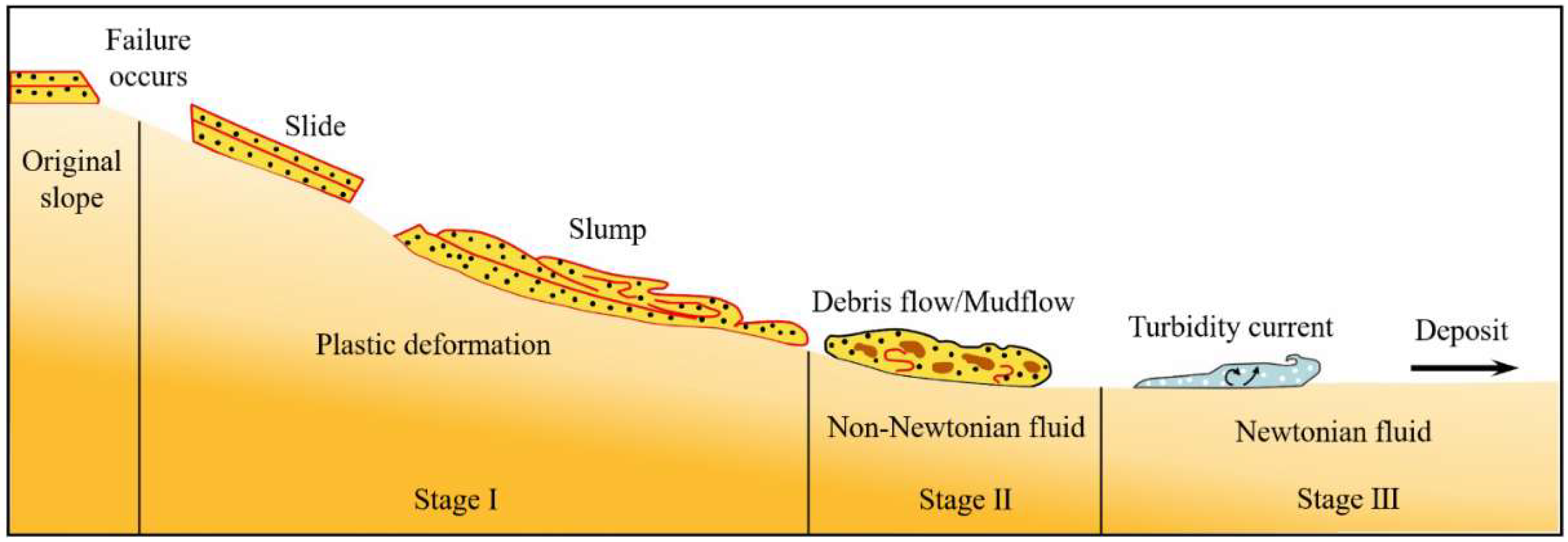
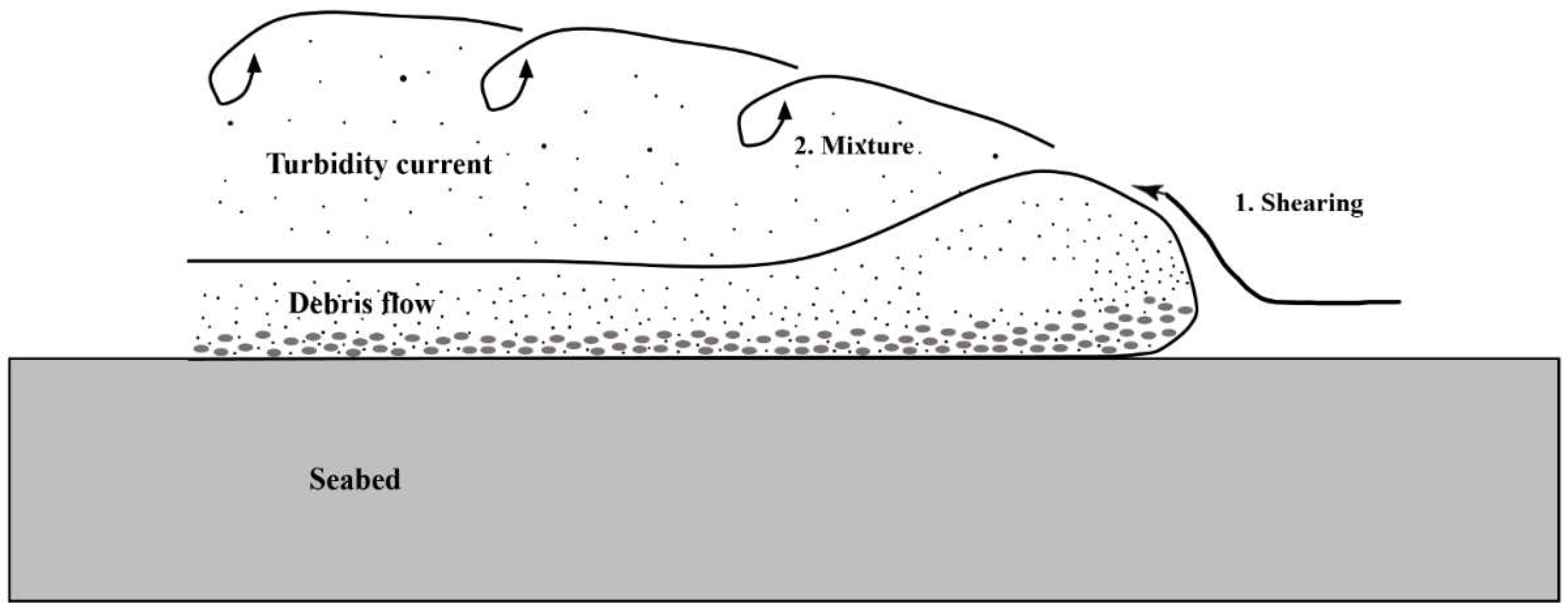

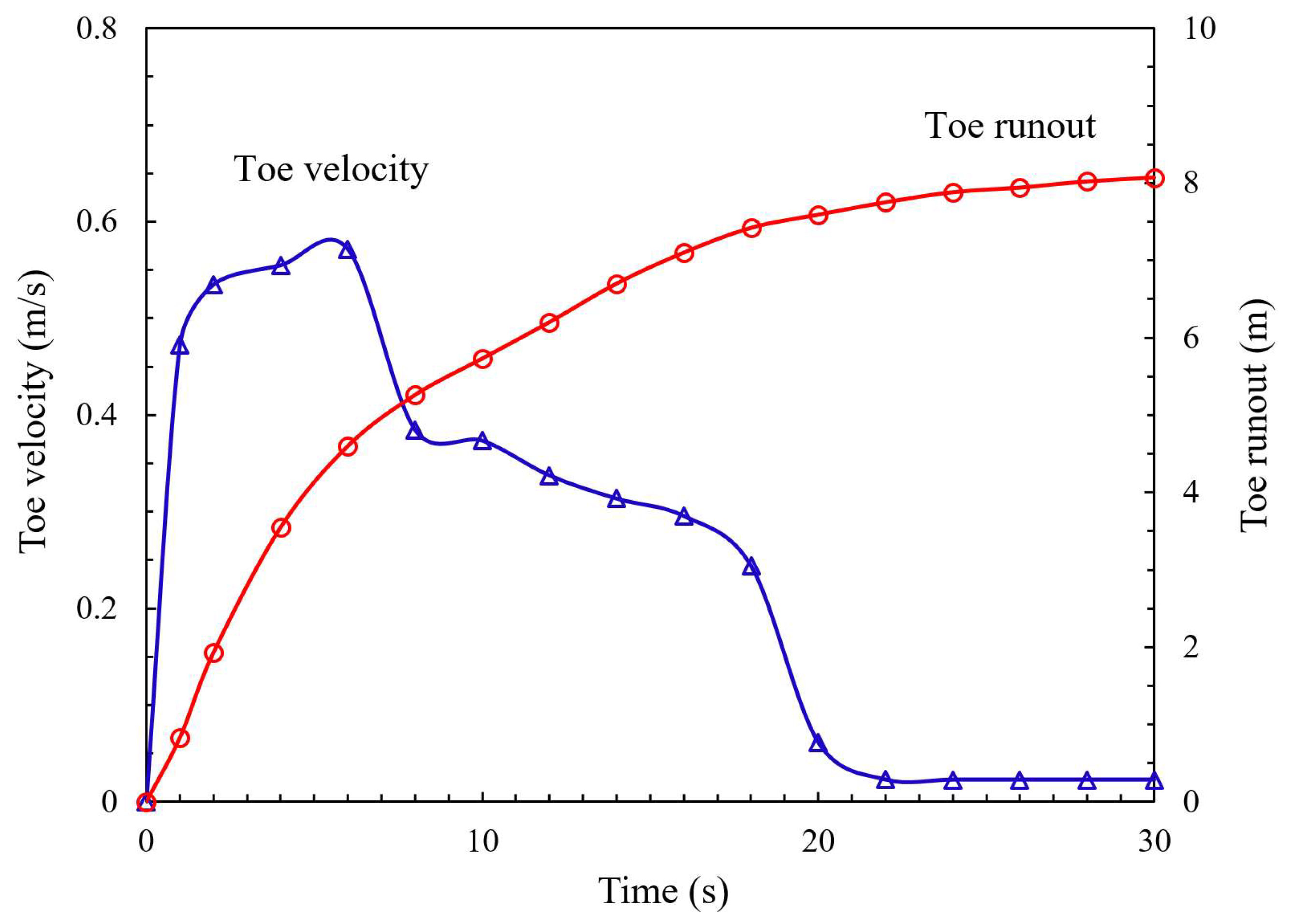

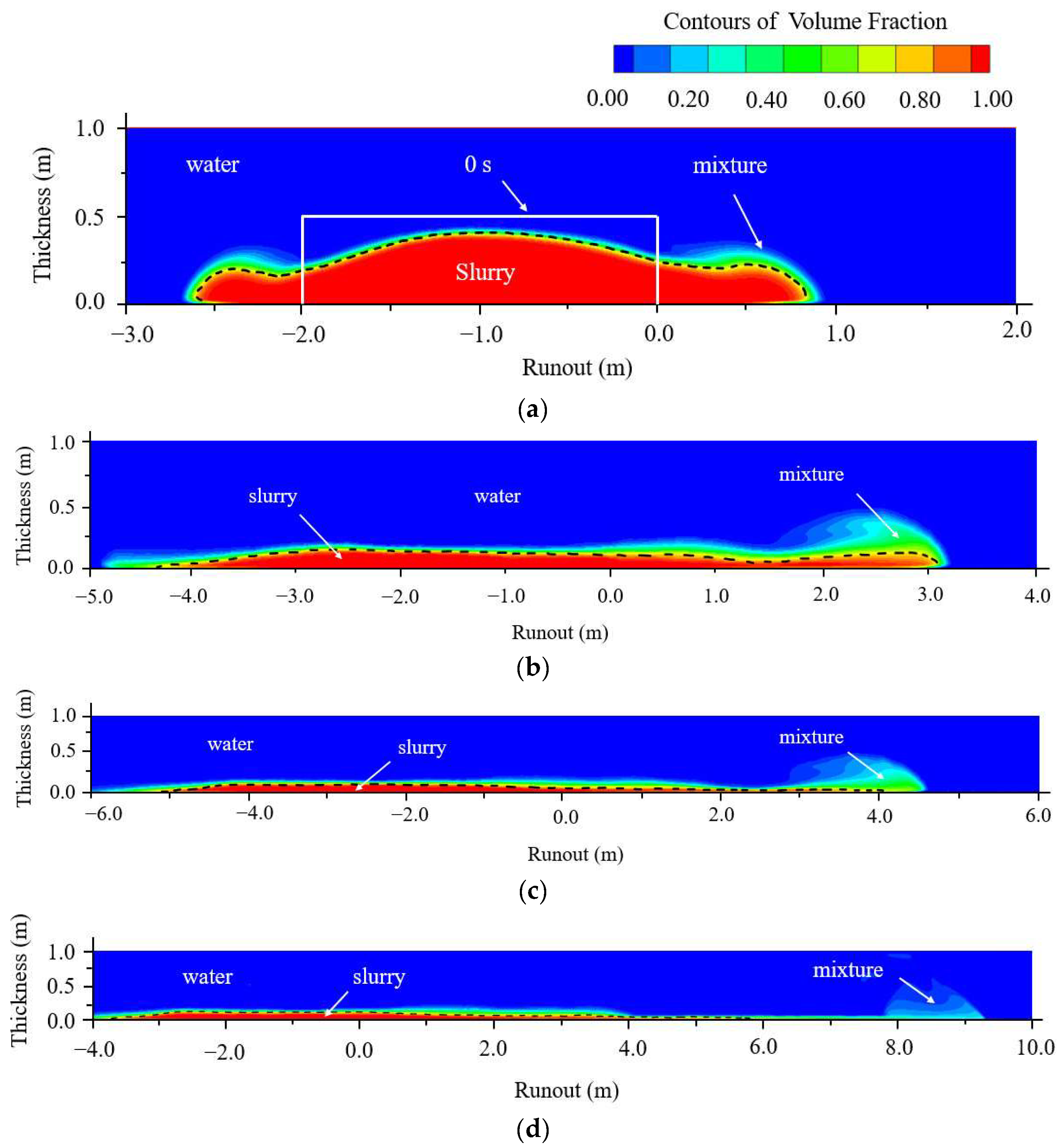
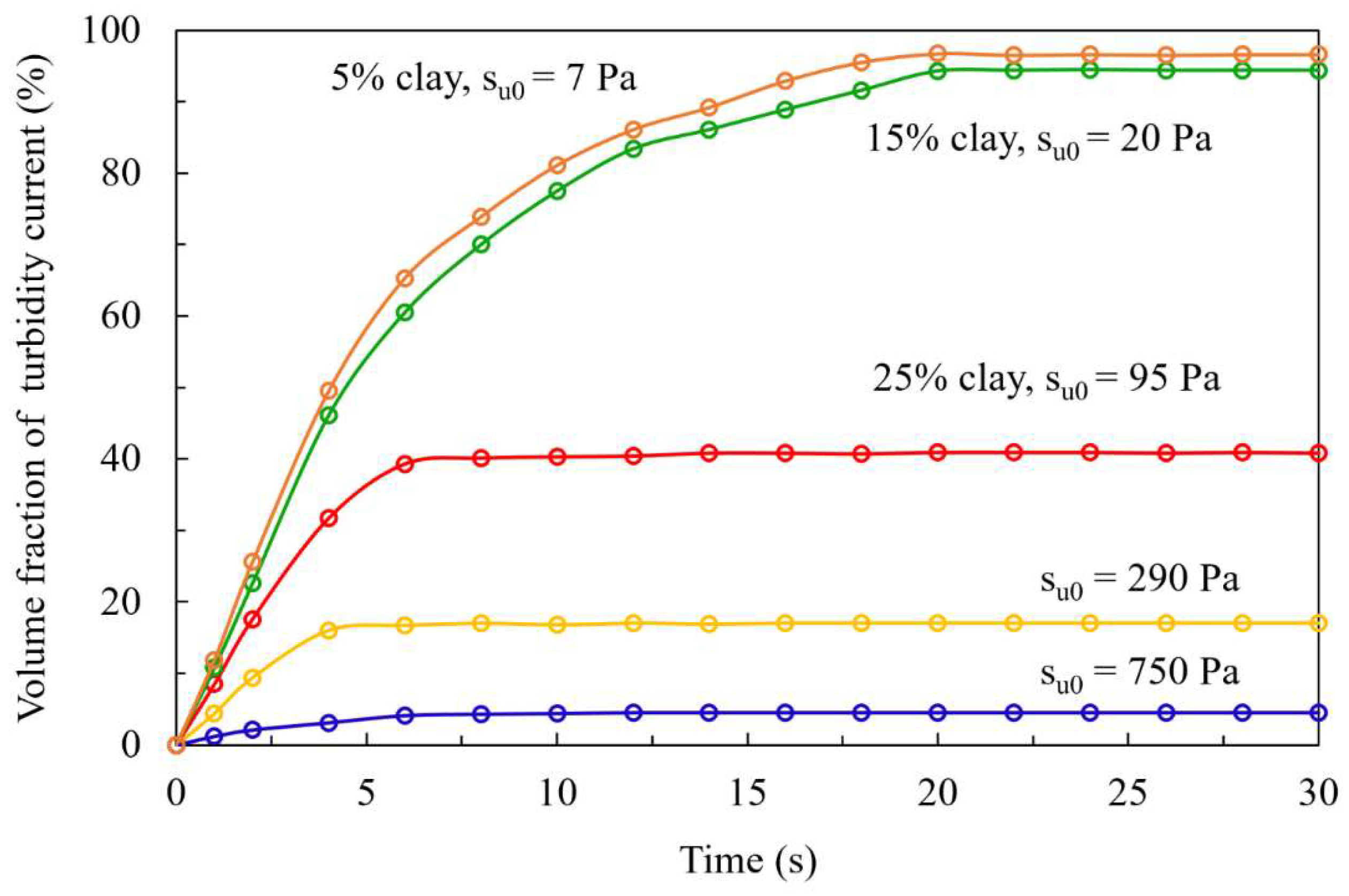




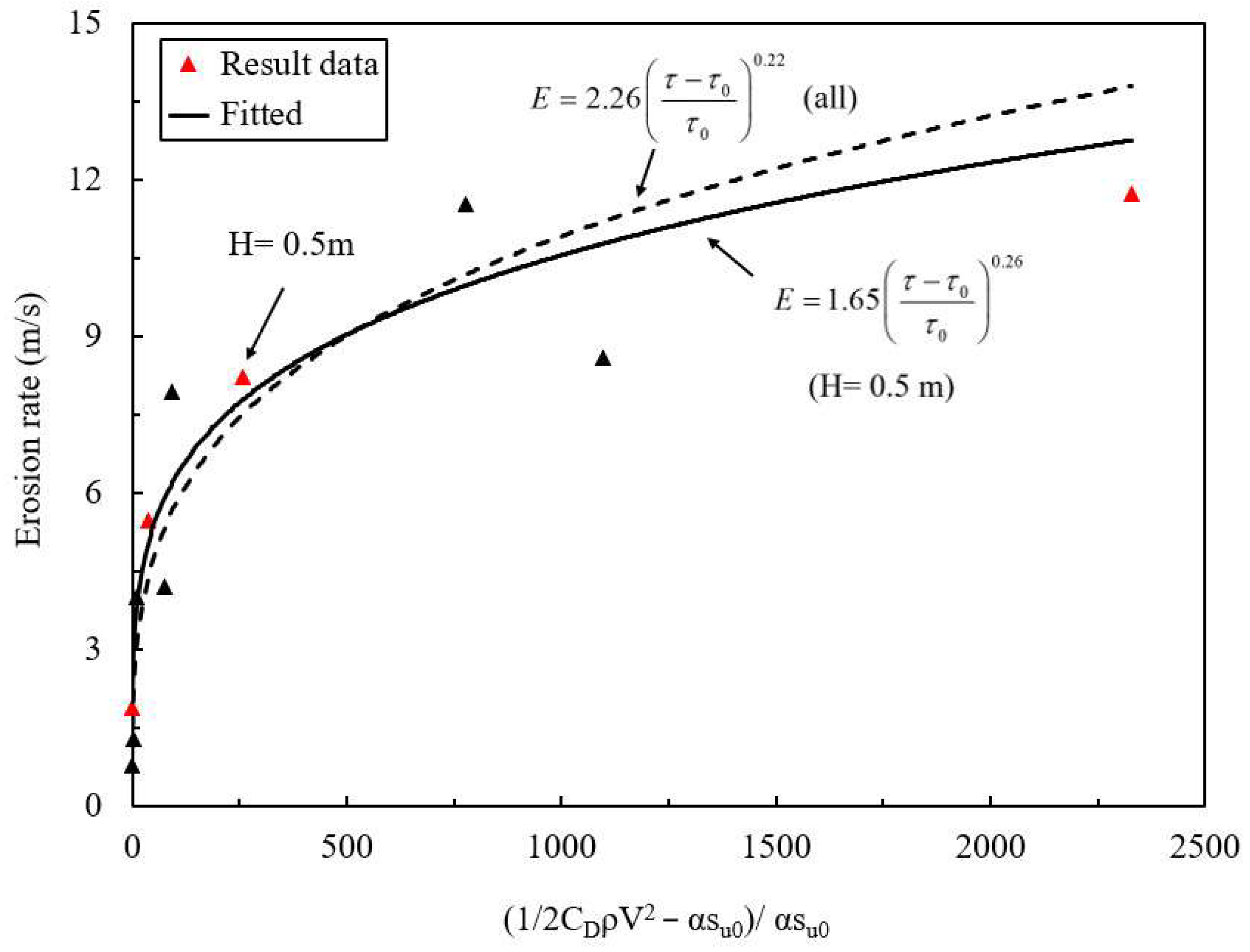

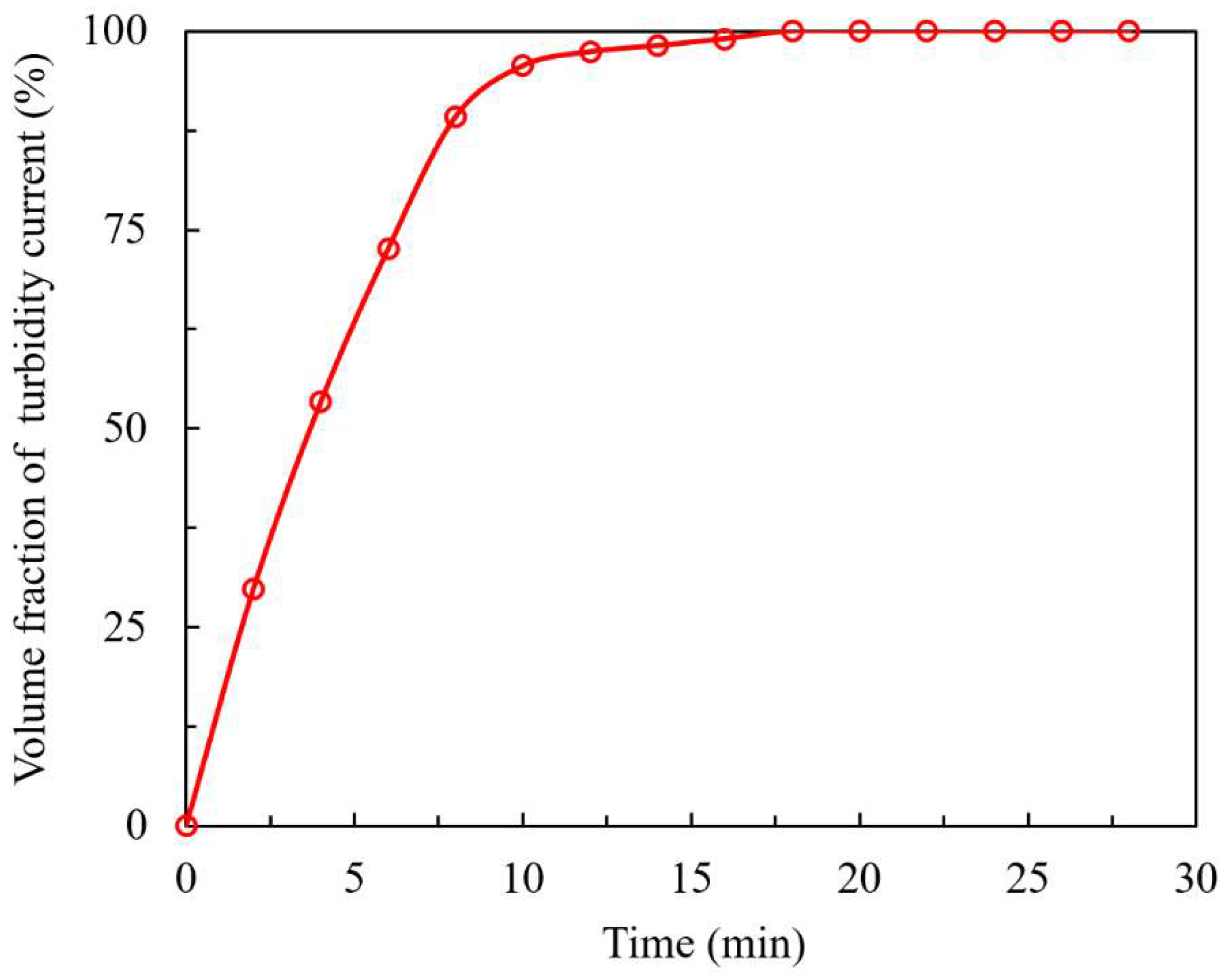
Disclaimer/Publisher’s Note: The statements, opinions and data contained in all publications are solely those of the individual author(s) and contributor(s) and not of MDPI and/or the editor(s). MDPI and/or the editor(s) disclaim responsibility for any injury to people or property resulting from any ideas, methods, instructions or products referred to in the content. |
© 2023 by the authors. Licensee MDPI, Basel, Switzerland. This article is an open access article distributed under the terms and conditions of the Creative Commons Attribution (CC BY) license (https://creativecommons.org/licenses/by/4.0/).
Share and Cite
Li, Y.; Dong, Y.; Chen, G. A Numerical Investigation of Transformation Rates from Debris Flows to Turbidity Currents under Shearing Mechanisms. Appl. Sci. 2023, 13, 4105. https://doi.org/10.3390/app13074105
Li Y, Dong Y, Chen G. A Numerical Investigation of Transformation Rates from Debris Flows to Turbidity Currents under Shearing Mechanisms. Applied Sciences. 2023; 13(7):4105. https://doi.org/10.3390/app13074105
Chicago/Turabian StyleLi, Yizhe, Youkou Dong, and Gang Chen. 2023. "A Numerical Investigation of Transformation Rates from Debris Flows to Turbidity Currents under Shearing Mechanisms" Applied Sciences 13, no. 7: 4105. https://doi.org/10.3390/app13074105




